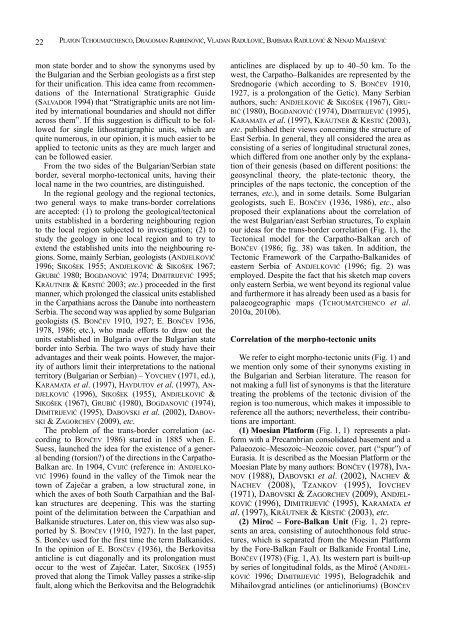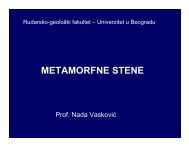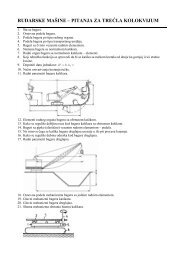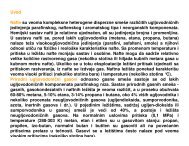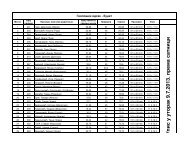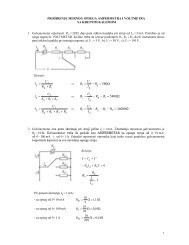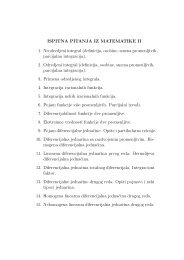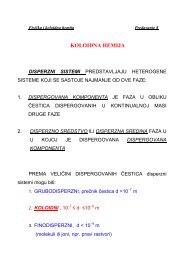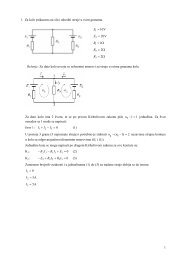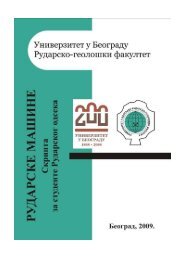KÑига LXXII
KÑига LXXII
KÑига LXXII
You also want an ePaper? Increase the reach of your titles
YUMPU automatically turns print PDFs into web optimized ePapers that Google loves.
22<br />
PLATON TCHOUMATCHENCO, DRAGOMAN RABRENOVIĆ, VLADAN RADULOVIĆ, BARBARA RADULOVIĆ & NENAD MALEŠEVIĆ<br />
mon state border and to show the synonyms used by<br />
the Bulgarian and the Serbian geologists as a first step<br />
for their unification. This idea came from recommendations<br />
of the International Stratigraphic Guide<br />
(SALVADOR 1994) that “Stratigraphic units are not limited<br />
by international boundaries and should not differ<br />
across them”. If this suggestion is difficult to be followed<br />
for single lithostratigraphic units, which are<br />
quite numerous, in our opinion, it is much easier to be<br />
applied to tectonic units as they are much larger and<br />
can be followed easier.<br />
From the two sides of the Bulgarian/Serbian state<br />
border, several morpho-tectonical units, having their<br />
local name in the two countries, are distinguished.<br />
In the regional geology and the regional tectonics,<br />
two general ways to make trans-border correlations<br />
are accepted: (1) to prolong the geological/tectonical<br />
units established in a bordering neighbouring region<br />
to the local region subjected to investigation; (2) to<br />
study the geology in one local region and to try to<br />
extend the established units into the neighbouring regions.<br />
Some, mainly Serbian, geologists (ANDJELKOVIĆ<br />
1996; SIKOŠEK 1955; ANDJELKOVIĆ & SIKOŠEK 1967;<br />
GRUBIĆ 1980; BOGDANOVIĆ 1974; DIMITRIJEVIĆ 1995;<br />
KRÄUTNER & KRSTIĆ 2003; etc.) proceeded in the first<br />
manner, which prolonged the classical units established<br />
in the Carpathians across the Danube into northeastern<br />
Serbia. The second way was applied by some Bulgarian<br />
geologists (S. BONČEV 1910, 1927; E. BONČEV 1936,<br />
1978, 1986; etc.), who made efforts to draw out the<br />
units established in Bulgaria over the Bulgarian state<br />
border into Serbia. The two ways of study have their<br />
advantages and their weak points. However, the majority<br />
of authors limit their interpretations to the national<br />
territory (Bulgarian or Serbian) – YOVCHEV (1971, ed.),<br />
KARAMATA et al. (1997), HAYDUTOV et al. (1997), AN-<br />
DJELKOVIĆ (1996), SIKOŠEK (1955), ANDJELKOVIĆ &<br />
SIKOŠEK (1967), GRUBIĆ (1980), BOGDANOVIĆ (1974),<br />
DIMITRIJEVIĆ (1995), DABOVSKI et al. (2002), DABOV-<br />
SKI & ZAGORCHEV (2009), etc.<br />
The problem of the trans-border correlation (according<br />
to BONČEV 1986) started in 1885 when E.<br />
Suess, launched the idea for the existence of a general<br />
bending (torsion?) of the directions in the Carpatho-<br />
Balkan arc. In 1904, CVIJIĆ (reference in: ANDJELKO-<br />
VIĆ 1996) found in the valley of the Timok near the<br />
town of Zaječar a graben, a low structural zone, in<br />
which the axes of both South Carpathian and the Balkan<br />
structures are deepening. This was the starting<br />
point of the delimitation between the Carpathian and<br />
Balkanide structures. Later on, this view was also supported<br />
by S. BONČEV (1910, 1927). In the last paper,<br />
S. Bončev used for the first time the term Balkanides.<br />
In the opinion of E. BONČEV (1936), the Berkovitsa<br />
anticline is cut diagonally and its prolongation must<br />
occur to the west of Zaječar. Later, SIKOŠEK (1955)<br />
proved that along the Timok Valley passes a strike-slip<br />
fault, along which the Berkovitsa and the Belogradchik<br />
anticlines are displaced by up to 40–50 km. To the<br />
west, the Carpatho–Balkanides are represented by the<br />
Srednogorie (which according to S. BONČEV 1910,<br />
1927, is a prolongation of the Getic). Many Serbian<br />
authors, such: ANDJELKOVIĆ & SIKOŠEK (1967), GRU-<br />
BIĆ (1980), BOGDANOVIĆ (1974), DIMITRIJEVIĆ (1995),<br />
KARAMATA et al. (1997), KRÄUTNER & KRSTIĆ (2003),<br />
etc. published their views concerning the structure of<br />
East Serbia. In general, they all considered the area as<br />
consisting of a series of longitudinal structural zones,<br />
which differed from one another only by the explanation<br />
of their genesis (based on different positions: the<br />
geosynclinal theory, the plate-tectonic theory, the<br />
principles of the naps tectonic, the conception of the<br />
terranes, etc.), and in some details. Some Bulgarian<br />
geologists, such E. BONČEV (1936, 1986), etc., also<br />
proposed their explanations about the correlation of<br />
the west Bulgarian/east Serbian structures, To explain<br />
our ideas for the trans-border correlation (Fig. 1), the<br />
Tectonical model for the Carpatho-Balkan arch of<br />
BONČEV (1986; fig. 38) was taken. In addition, the<br />
Tectonic Framework of the Carpatho-Balkanides of<br />
eastern Serbia of ANDJELKOVIĆ (1996; fig. 2) was<br />
employed. Despite the fact that his sketch map covers<br />
only eastern Serbia, we went beyond its regional value<br />
and furthermore it has already been used as a basis for<br />
palaeogeographic maps (TCHOUMATCHENCO et al.<br />
2010a, 2010b).<br />
Correlation of the morpho-tectonic units<br />
We refer to eight morpho-tectonic units (Fig. 1) and<br />
we mention only some of their synonyms existing in<br />
the Bulgarian and Serbian literature. The reason for<br />
not making a full list of synonyms is that the literature<br />
treating the problems of the tectonic division of the<br />
region is too numerous, which makes it impossible to<br />
reference all the authors; nevertheless, their contributions<br />
are important.<br />
(1) Moesian Platform (Fig. 1, 1) represents a platform<br />
with a Precambrian consolidated basement and a<br />
Palaeozoic–Mesozoic–Neozoic cover, part (“spur”) of<br />
Eurasia. It is described as the Moesian Platform or the<br />
Moesian Plate by many authors: BONČEV (1978), IVA-<br />
NOV (1988), DABOVSKI et al. (2002), NACHEV &<br />
NACHEV (2008), TZANKOV (1995), IOVCHEV<br />
(1971), DABOVSKI & ZAGORCHEV (2009), ANDJEL-<br />
KOVIĆ (1996), DIMITRIJEVIĆ (1995), KARAMATA et<br />
al. (1997), KRÄUTNER & KRSTIĆ (2003), etc.<br />
(2) Miroč – Fore-Balkan Unit (Fig. 1, 2) represents<br />
an area, consisting of autochthonous fold structures,<br />
which is separated from the Moesian Platform<br />
by the Fore-Balkan Fault or Balkanide Frontal Line,<br />
BONČEV (1978) (Fig. 1, A). Its western part is built-up<br />
by series of longitudinal folds, as the Miroč (ANDJEL-<br />
KOVIĆ 1996; DIMITRIJEVIĆ 1995), Belogradchik and<br />
Mihailovgrad anticlines (or anticlinoriums) (BONČEV


